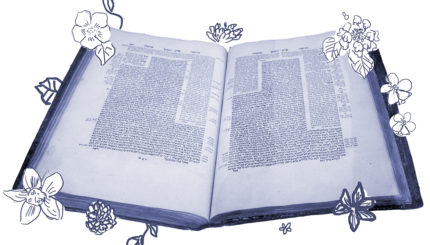Today’s daf introduces a number of important concepts that the rabbis use to differentiate between the halakhic obligation of men and women. We’ll revisit these ideas in future pages, but for today we’re going to focus on a character who appears only once in the Talmud: the seven-headed demon who haunts Abaye’s study house.
The Talmud tells us that Rav Aha bar Yaakov went to study Torah with Abaye.
Abaye heard he was coming. There was a certain demon in the study hall of Abaye that when two enter they would be harmed, even during the day.
We’ve already learned that demons don’t harm people in groups of two, and also that they don’t often attack during the day. And yet, apparently this demon is so malevolent and harmful that he attacks even those who should be relatively safe. So what does Abaye decide to do?
With your help, My Jewish Learning can provide endless opportunities for learning, connection and discovery.
He said to them: Do not give lodging, and perhaps a miracle will occur.
In different periods of Jewish history, yeshiva students who could not afford to rent a room slept in the study hall. Evidently Abaye hopes that Rav Aha bar Yaakov will be forced to inhabit the study hall and engage in a battle with the demon for the right to occupy it.
Rabbi Aha bar Yaakov entered and spent the night in that study hall of the sages. (The demon) appeared to him like a serpent with seven heads. Every bow he bowed one head fell off.
To modern readers, a seven-headed serpent demon sounds both awesome and terrifying. But it would likely have been a common image in ancient Babylonia. Numerous accounts from ancient Mesopotamia and Ugarit tell of primordial combat between an evil seven-headed serpent or dragon and a divine hero. The Talmud here is picking up on what likely was a common trope shared across cultures. And the shared nature of the image may also explain why this demon — unlike almost every other demon in the Talmud — seems to be entirely evil and out to get the rabbis.
But unlike the more common ancient combat myths, here the serpent-demon is vanquished not through physical combat but through … bowing. When the rabbis of the Talmud mention bowing, they are usually alluding to prayer, so we are likely meant to imagine Rabbi Aha using the power of prayer to vanquish the evil demon. And that too is part of broader cultural tropes — of Jewish, Christian and Zoroastrian holy people vanquishing demons through prayer. (For a deeper look at the appearance of the seven-headed creature in other cultural traditions, I wrote an academic paper on the subject you can read here.)
Rav Aha’s greatness, piety and perhaps eagerness to learn from Abaye help him fight the demon and win. Torah scholars are now safe to enter and study together.
But before you go seek out a career as an exorcist, let’s note that the story ends with a word of caution:
The next day Rav Aha said to them: If a miracle had not occurred, you would have placed me in danger.
While Abaye’s gambit ultimately worked, it would have killed Rav Aha if it hadn’t. And Rav Aha, for one, did not appreciate that at all.
Read all of Kiddushin 29 on Sefaria.
This piece originally appeared in a My Jewish Learning Daf Yomi email newsletter sent on September 11th, 2023. If you are interested in receiving the newsletter, sign up here.



